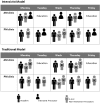Resident and Preceptor Perceptions of Preceptor Integration Into Resident Clinic Scheduling Templates
- PMID: 28824765
- PMCID: PMC5559247
- DOI: 10.4300/JGME-D-16-00609.1
Resident and Preceptor Perceptions of Preceptor Integration Into Resident Clinic Scheduling Templates
Abstract
Background: Some internal medicine residency programs on X+Y schedules have modified clinic preceptor schedules to mimic those of the resident cohort (resident matched). This is in contrast to a traditional model, in which preceptors supervise on the same half-day each week.
Objective: We assessed preceptor and resident perceptions of the 2 precepting models.
Methods: We surveyed 44 preceptors and 97 residents at 3 clinic sites in 2 academic medical centers. Two clinics used the resident-matched model, and 1 used a traditional model. Surveys were completed at 6 months and 1 year. We assessed resident and preceptor perceptions in 5 domains: relationships between residents and preceptors; preceptor familiarity with complex patients; preceptor ability to assess milestone achievements; ability to follow up on results; and quality of care.
Results: There was no difference in perceptions of interpersonal relationships or satisfaction with patient care. Preceptors in the resident-matched schedule reported they were more familiar with complex patients at both 6 months and 1 year, and felt more comfortable evaluating residents' milestone achievements at 6 months, but not at 1 year. At 1 year, residents in the resident-matched model perceived preceptors were more familiar with complex patients than residents in the traditional model. The ability to discuss patient results between clinic weeks was low in both models.
Conclusions: The resident-matched model increased resident and preceptor perceptions of familiarity with complex patients and early preceptor perceptions of comfort in assessment of milestone achievements.
Conflict of interest statement
Conflict of interest: Dr Aagaard receives small stipends from the American Board of Internal Medicine and the National Board of Medical Examiners for board-related work. This study was presented as a poster at the Society of General Internal Medicine New England Regional Meeting, Boston, Massachusetts, March 11, 2016; as a poster at the Society of General Internal Medicine National Meeting, Hollywood, Florida, May 10, 2016; and as an oral presentation at the University of Vermont Teaching Academy Mud Season Retreat, Burlington, Vermont, April 14–15, 2016.
Figures
References
-
- Bowen JL, Hirsh D, Aagaard E, et al. . Advancing educational continuity in primary care residencies: an opportunity for patient-centered medical homes. Acad Med. 2015; 90 5: 587– 593. - PubMed
-
- Willett LL, Estrada CA, Adams M, et al. . Challenges with continuity clinic and core faculty accreditation requirements. Am J Med. 2013; 126 6: 550– 556. - PubMed
MeSH terms
LinkOut - more resources
Full Text Sources
Other Literature Sources

